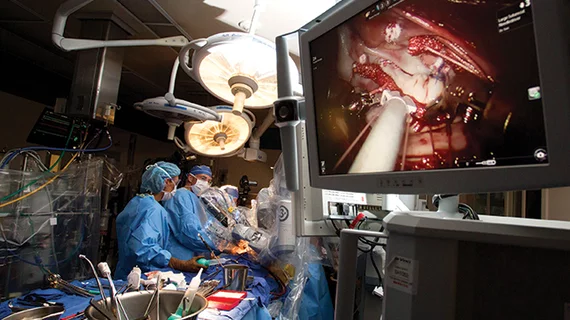Study calls for earlier intervention on mitral valves
Mitral valve operations are the fastest-growing type of heart procedure, according to an analysis of the Society of Thoracic Surgeons’ Adult Cardiac Surgery database—but researchers believe interventions at earlier stages could further improve outcomes.
“This study shows that a significant number of patients are still referred for mitral valve surgery later than they should be,” lead author James S. Gammie, MD, from the University of Maryland School of Medicine in Baltimore, said in a press release. “In these cases, the malfunctioning mitral valve has caused significant damage to the heart and/or lungs, and while an operation can be performed, long-term outcomes will be compromised, to some extent.”
Gammie and colleagues published their paper online July 18 in The Annals of Thoracic Surgery.
They studied 87,214 patients from 1,125 facilities who had isolated primary mitral valve operations from July 2011 to September 2016. They found a 24 percent increase in number of procedures performed in 2016 versus 2011, including a 44 percent increase for patients with degenerative leaflet prolapse (DLP)—the most common type of mitral valve disease which advances with age.
“This suggests that the mitral valve disease may have reached a chronic stage prior to referral for operation, which means that heart and lung damage may not be fully reversible,” said coauthor Vinay Badhwar, MD, from West Virginia University. “In these patients, their symptoms may improve after surgery, but their life expectancy may be reduced.”
Total operative mortality in the data set was around 2 percent, including 3.7 percent for valve replacement and 1.1 percent for repairs. About 66 percent of the operations in the study were replacements and the other 34 percent were repairs. Patients were 64 years old on average and 34.2 percent had atrial fibrillation.
Given the advanced disease state of many of the individuals, the authors concluded that contemporary mitral valve operation results are “excellent,” but could be further improved with earlier intervention. They noted mitral valve disease is two to three times more common than aortic valve disease, but aortic valve interventions occurred 1.6 times more often during the study period.
“That may suggest important underreferral and undertreatment of (mitral valve) disease, which may be related to the slower progression of signs and symptoms of mitral disease compared with aortic disease, as well as a potential lack of adherence to guidelines for intervention,” the researchers wrote.

